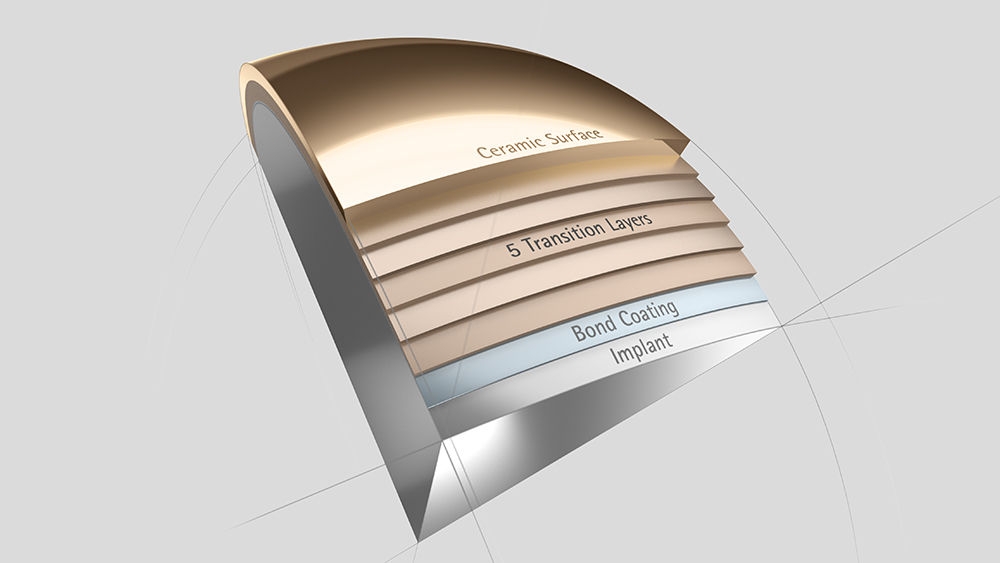You have successfully logged out.
Not registered yet?
Learn about the risks and questions to ask your surgeon before surgery
Metal Allergy and Knee Implants
If you’re preparing for knee replacement surgery, you're likely focused on what life will look like after—more comfort, better mobility, and getting back to the things you love. That's the goal of total knee arthroplasty (TKA), and for most patients, it’s a highly successful procedure.
However, like with any medical treatment, it's important to understand the full picture. One area that’s gaining more attention is the role of metals in knee implants and how our bodies may respond to them.1 This is important to understand and discuss with your surgeon before your surgery is planned.
Why Do Knee Implants Contain Metal?
Your knee implant needs to be strong and durable to support everyday movements. That's why many implants use metal alloys—typically cobalt-chromium-molybdenum (CoCrMo). These metals are especially important in the thigh bone (femoral) component because they resist wear and provide strength.2
Unlike many hip replacements that now use ceramic materials, most knee implants still rely on these metal alloys to withstand the forces of walking, standing, and bending.
Understanding Metal Hypersensitivity
Something that doesn't get discussed as often, during pre-operative conversations between patient and surgeon, is metal hypersensitivity — essentially an allergic reaction to metal ion that is released from wear of your implant.
-
Around
0%
40% of people worldwide have allergic reactions to foreign proteins in their environment.3
-
About
0%
of people have some level of metal sensitivity, and we now recognize this as a potential cause of knee replacement complications.4
Why Are Allergies on the Rise?
One major reason, for allergies to be on the rise, seems to be our changing environment. While genetics play a role, the rapid increase in allergies and autoimmune diseases points more strongly to outside factors like pollution, industrial chemicals, and even what we’re exposed to in our homes and workplaces.
For example, heavy metals — such as cobalt (Co), chromium (Cr), copper (Cu), and lead (Pb) — are found in many everyday sources. From traffic pollution and cigarette smoke to certain fertilizers and even the water we drink, we’re often exposed without realising it. These metals can enter the body through breathing, eating, or even skin contact.7
What Does This Have to Do With Implants?
Many medical devices, including dental fillings, contraceptive devices, pacemakers, and joint implants like artificial knees and hips, may contain trace amounts of these metals. Most people tolerate these implants very well. But for some individuals, especially those with an overactive immune system or existing allergies, these metals can trigger what’s known as Delayed-Type Metal Hypersensitivity reaction.
This kind of reaction doesn’t always happen right away, and symptoms can sometimes be vague things like ongoing inflammation, skin rashes, joint pain, or swelling. If you already know you have sensitivities to metals like nickel or cobalt, or if you’ve had trouble with reactions to jewellery or suffer from eczema, asthma or Hay-fever, it’s important to tell your doctor before any surgery or implant procedure.5
For a small number of patients, the body can react to tiny metal ions that may wear off from the implant over time. These metal ions can be released into your surrounding tissue, especially if the implant experiences damage or unusual stress (it is called metallosis).
What You Should Know About Metal Wear in Knee Implants
Even though many hip replacements now use ceramic materials, most knee implants still rely on a strong metal alloy made of cobalt, chromium, and molybdenum (CoCrMo).
This metal helps the implant last through everyday activities like walking and bending—but like any material, it can wear down over time.
Researchers are learning that some wear and tear on these metal knee components may release tiny metal ions into the surrounding tissue. In most cases, this doesn’t cause any noticeable problems. However, in some people, it may lead to local reactions like inflammation or, more rarely, even a reaction from the immune system. These reactions are similar to what was seen in hip implants and can sometimes result in pain, swelling, or the need for further surgery.
A recent study looked at 51 knee implants that had been removed during revision surgery.6 Of these, the researchers found that the patients with the implants that had more visible wear had higher levels of cobalt, chromium, and molybdenum levels in their surrounding joint tissue. This means that as the metal wears, more of it is absorbed into your body.
They also found that metal debris can be released in different ways—during surgery, when the metal parts are first put in, and later through regular use of the joint. Even small contact between parts, or tiny particles caught between them, can cause extra wear.
This doesn’t mean metal implants are unsafe. In fact, they’re used successfully in thousands of surgeries every year. But for certain patients — especially those who are sensitive to metals or have a history of allergies — it’s something you should discuss with your surgeon and take steps to reduce your risk of this complication.
When your immune system reacts to these metals (commonly nickel, cobalt, and chromium), you might experience symptoms such as:2
- Persistent pain around your knee
- Swelling and inflammation
- Stiffness and reduced range of motion
- Skin reactions like dermatitis or eczema in the area
- In some cases, implant failure requiring revision surgery
Are You at Higher Risk?
You might have a higher risk of metal sensitivity if:
- You get skin irritations from jewellery
- You have existing skin conditions like dermatitis, eczema, or psoriasis
- You've experienced unexplained skin rashes in the past
- You have a history of allergic reactions
- You have a history of eczema, asthma and/or hay-fever (referred to the ‘Atopic March’)
If any of these apply to you, metal hypersensitivity may be something worth investigating before your surgery.
Testing for Metal Sensitivity
The good news is that you can be tested for metal sensitivity before your surgery. There are two main testing methods:
1. Skin patch testing: This is the most widely available and less expensive option. It involves placing patches containing specific metal allergens on your skin and watching for reactions.
2. Lymphocyte Transformation Test (LTT): This blood test measures your immune response to metals and may be more accurate for detecting hypersensitivity, though it requires more time and is more expensive.
Alternatively, if you cannot or do not wish to be tested, you can opt for a coated implant that has an Advanced Surface that protects you from Metal Ion release from your implant.
Solutions for Metal Sensitivity
If your test results indicate you might be sensitive to metals, there are specialised options available:
Coated implants have been developed specifically to address this concern. These implants 7,8:
- Provide a physical barrier between metal alloys and your body's tissues
- Use hypoallergenic coatings like ceramic, titanium, or zirconium
- Help prevent the release of metal ions into your body
The most effective coated implants have multiple protective layers, with seven-layer coatings considered the gold standard for patients with metal sensitivity.8

7 layers to protect you
Our multilayer surface coating for knee implants forms an effective barrier against allergic reactions while simultaneously providing stability and improved scratch resistance. To protect you in the best possible way.
1. Lachiewicz PF, Watters TS, Jacobs JJ. Metal Hypersensitivity and Total Knee Arthroplasty. J Am Acad Orthop Surg. 2016 Feb;24(2):106-12. doi: 10.5435/JAAOS-D-14-00290. PMID: 26752739; PMCID: PMC4726476. https://pmc.ncbi.nlm.nih.gov/articles/PMC4726476/
2. MedBroadcast. (n.d.). Metal hypersensitivity. Retrieved April 24, 2025, from https://medbroadcast.com/condition/getcondition/metal-hypersensitivity
3. World Health Organization. White Book on Allergy 2011-2012 Executive Summary. By Prof. Ruby Pawankar, MD, PhD, Prof. Giorgio Walkter Canonica, MD, Prof. Stephen T. Holgate, BSc, MD, DSc, FMed Sci and Prof. Richard F. Lockey, MD.
4. Innocenti M, Vieri B, Melani T, Paoli T, Carulli C. Metal hypersensitivity after knee arthroplasty: fact or fiction? Acta Biomed. 2017 Jun 7;88(2S):78-83. doi: 10.23750/abm.v88i2-S.6517. PMID: 28657568; PMCID: PMC6178998.
5. Sajad Chamani, Leila Mobasheri, Zeinab Rostami, Iman Zare, Ali Naghizadeh, Ebrahim Mostafavi,Heavy metals in contact dermatitis: A review, Journal of Trace Elements in Medicine and Biology, Volume 79,2023,127240,ISSN 0946-672X, https://doi.org/10.1016/j.jtemb.2023.127240. (https://www.sciencedirect.com/science/article/pii/S0946672X23001165.
6. Peter W. Kurtz, Shabnam Aslani, Michael A. Kurtz, Lilliana M. Taylor, Emma R. Barnes, Daniel W. MacDonald, Nicolas S. Piuzzi, William M. Mihalko, Steven M. Kurtz, Jeremy L. Gilbert, Cobalt-Chromium-Molybdenum Femoral Knee Implant Damage Correlates With Elevated Periprosthetic Metal Concentrations, The Journal of Arthroplasty,2025,ISSN 0883-5403, https://doi.org/10.1016/j.arth.2025.02.075.(https://www.sciencedirect.com/science/article/pii/S0883540325002037)
7. Lützner, J., Hartmann, A., Dinnebier, G. et al. Metal hypersensitivity and metal ion levels in patients with coated or uncoated total knee arthroplasty: a randomised controlled study. International Orthopaedics (SICOT) 37, 1925–1931 (2013). https://doi.org/10.1007/s00264-013-2010-6.
8. Reich J, Hovy L, Lindenmaier HL, Zeller R, Schwiesau J, Thomas P, Grupp TM. Präklinische Ergebnisse beschichteter Knieimplantate für Allergiker [Preclinical evaluation of coated knee implants for allergic patients]. Orthopade. 2010 May;39(5):495-502. German. doi: 10.1007/s00132-009-1581-9. PMID: 20091294. https://pubmed.ncbi.nlm.nih.gov/20091294/


